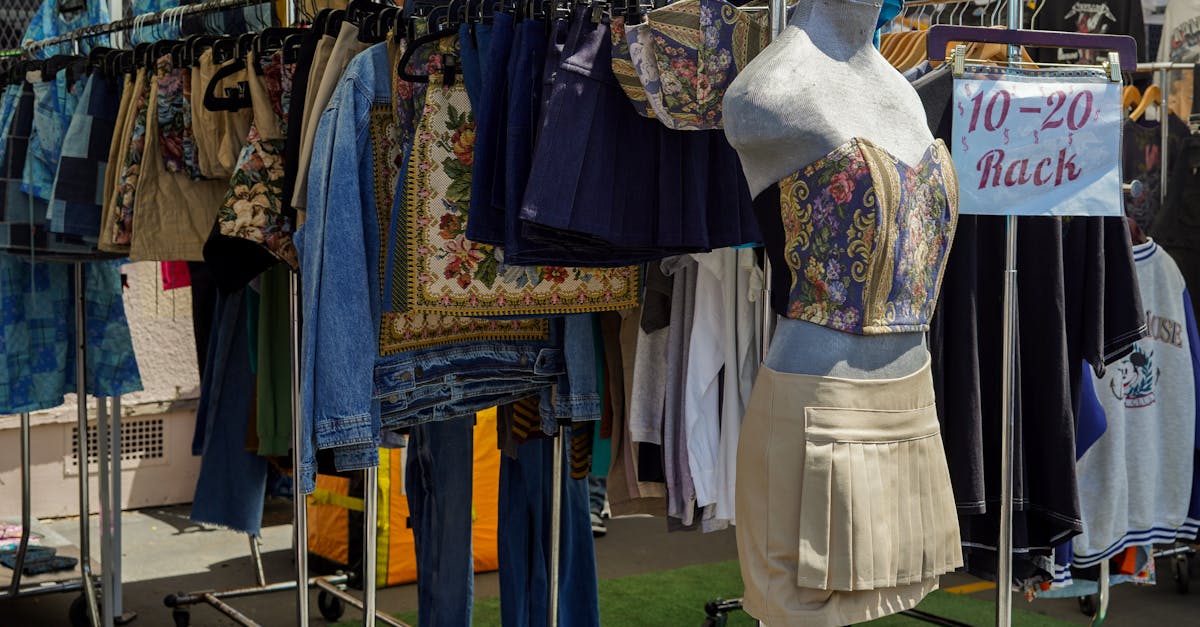Fashioning a Greener Tomorrow: A Guide for Sustainable Clothing Brands

Welcome to a sustainable fashion revolution! In today’s fast-paced world, the fashion industry is undergoing a profound transformation, and eco-conscious brands are leading the way. This article delves into the essential tips for building a sustainable clothing brand, focusing on eco-friendly practices, market opportunities, design considerations, supply chain transparency, brand storytelling, and measuring sustainability impact. With an increasing emphasis on environmental and social responsibility, the significance of sustainable clothing brands cannot be overstated. Understanding the demand for ethical and environmentally friendly fashion choices, this article serves as a comprehensive guide for individuals, entrepreneurs, and businesses looking to navigate the landscape of eco-conscious fashion successfully. From defining sustainable fashion to crafting a compelling brand narrative and implementing social responsibility initiatives, each section provides valuable insights and actionable strategies, empowering you to make a meaningful impact in the fashion industry while prioritizing our planet and its people.
1. Understanding Sustainable Fashion
Thank you for reading this post, don't forget to subscribe!
The significance of sustainable clothing brands is not just a passing phase; it’s a fundamental shift in the industry’s ethos. Consumers are increasingly drawn to brands that champion sustainability, seeking products that align with their eco-conscious values. From reducing carbon footprints to promoting fair labor practices, sustainable fashion prioritizes the well-being of workers, communities, and the environment. As the demand for ethical and environmentally responsible fashion continues to rise, sustainable fashion is poised to become the new standard, shaping the industry’s future trajectory.
As we embrace the significance of sustainable fashion, it’s essential to recognize its broader implications. Sustainable clothing brands are not just creating products; they are fostering a culture of mindfulness, fostering unity between style and sustainability. With an unwavering commitment to positive change, sustainable fashion is leading the way towards a brighter, more responsible future for the fashion industry and beyond.
Definition of Sustainable Fashion
Sustainable fashion, beyond being a buzzword, represents a philosophy that transforms the way we view and produce clothing. It encompasses an ethos that prioritizes environmental integrity and the well-being of individuals throughout the supply chain. At its core, sustainable fashion seeks to reduce the industry’s footprint by embracing eco-friendly materials, ethical production methods, and mindful consumption. This approach emphasizes the creation of timeless, durable pieces, and rejects the fast-paced, disposable nature of conventional fashion, fostering a culture of conscientiousness and respect.
The impact of sustainable fashion extends far beyond the garments themselves. By promoting sustainable practices, the fashion industry contributes to broader environmental and social causes. Sustainability in fashion aims to minimize pollution, conserve natural resources, and support fair labor conditions, all while stimulating innovation and creativity. Furthermore, it empowers consumers to make informed choices, inspiring a shift towards mindful and intentional consumption habits that benefit both society and the planet.
In exploring the concept of sustainability in fashion, it is essential to recognize that sustainable fashion is not a fleeting trend but a paradigm that challenges the status quo. Embracing sustainability means acknowledging the interconnectedness of our actions and their repercussions on the world around us. As we delve into this topic, we uncover a transformative approach that not only redefines the fashion industry but also paves the way for a more harmonious coexistence between fashion, the environment, and society.
Importance of Eco-conscious Practices
The importance of eco-conscious practices in the fashion industry cannot be overstated, as consumers increasingly seek sustainable and ethical fashion choices. This growing consumer demand has sparked a remarkable shift in the way fashion brands approach production, design, and transparency. Eco-conscious practices in fashion represent a commitment to minimizing environmental impact and prioritizing ethical considerations throughout the entire lifecycle of a garment. By embracing eco-conscious practices, fashion brands not only meet consumer expectations but also contribute to a more sustainable and responsible industry.
As eco-consciousness takes center stage, consumers are using their purchasing power to advocate for positive change within the fashion landscape. The significance of environmentally friendly and ethical fashion choices lies in their potential to shape the industry’s future. Consumers are drawn to brands that uphold sustainability principles, driving the market towards greater accountability, transparency, and innovation. The rise of eco-conscious practices reflects a collective awareness and dedication to fostering positive, long-lasting impacts on the environment and society.
Furthermore, the importance of eco-conscious practices in fashion extends beyond consumer preferences; it embodies a global movement towards greater environmental mindfulness. By prioritizing eco-friendly and ethical fashion choices, the industry is evolving into one that embraces sustainability as a core value, thereby influencing and inspiring other sectors to follow suit, ultimately paving the way for a more sustainable and balanced future.
2. Identifying Market Opportunities

Identifying market opportunities in sustainable fashion involves recognizing the ever-expanding landscape for eco-friendly and ethical clothing. This dynamic market presents tremendous potential for growth, innovation, and positive change within the fashion industry. As consumer preferences continue to evolve, sustainable fashion has transcended niche markets, demonstrating widespread appeal and driving significant opportunities for brands to redefine their strategies and offerings.
The expanding market for sustainable fashion is not only indicative of changing consumer tastes but also reflects a broader shift towards conscious and mindful living. Consumers are seeking products that align with their values, leading to a surge in demand for sustainable and ethically produced clothing. This demand has created a vibrant space for entrepreneurs, designers, and established brands to innovate, collaborate, and meet the rising consumer expectations for environmentally friendly and socially responsible fashion choices.
Moreover, as sustainable fashion gains momentum, it opens doors for fresh and innovative business models that prioritize sustainability. From circular economy initiatives to the rise of rental and second-hand clothing platforms, the market presents diverse avenues for growth and creativity. Embracing market opportunities for sustainable fashion not only fosters economic growth but also contributes to a more inclusive, transparent, and sustainable fashion landscape, enriching the industry and nurturing a community dedicated to positive change.
Trends in Sustainable Fashion
Trends in sustainable fashion reflect the evolving consumer landscape, showcasing current and emerging preferences driving the demand for eco-friendly and ethical clothing brands. Understanding these trends is essential for brands looking to align their offerings with the values and expectations of today’s conscientious consumers. One notable trend is the growing emphasis on transparency and traceability throughout the supply chain. Consumers are demanding greater visibility into the production processes, material sourcing, and labor conditions, driving brands to adopt more transparent practices and engage in open dialogue with their audience.
Another prominent trend is the rise of circular and regenerative fashion practices. Consumers are increasingly drawn to brands that embrace circular economy principles, such as recycling, upcycling, and designing for longevity. This trend underscores a shift towards mindful consumption and a desire to minimize waste, showcasing the appeal of brands that prioritize sustainability throughout the entire lifecycle of their products.
Furthermore, an increasing focus on innovation and technology in sustainable fashion is shaping consumer trends. From the use of cutting-edge sustainable materials to advancements in eco-friendly production processes, consumers are seeking products that seamlessly integrate style and sustainability. This trend highlights the fusion of creativity and environmental consciousness, driving the demand for fashion that not only looks good but also upholds ethical and sustainable principles.
Market Research and Analysis
Market research and analysis play a pivotal role in understanding and catering to the dynamic landscape of sustainable fashion. By leveraging market insights, brands can identify niche areas and discern evolving consumer preferences, ensuring that their offerings align with the ever-changing demands of conscious consumers. Utilizing this research, brands can uncover key trends, unmet needs, and emerging opportunities, enabling them to enhance their product offerings and engagement strategies.
In the realm of sustainable fashion, market research offers a window into the diverse and evolving preferences of eco-conscious consumers. It provides valuable data on consumer behaviors, preferences for sustainable materials, buying patterns, and the impact of ethical considerations. By delving deep into this information, brands can tailor their products and messaging to resonate with their audience and address specific sustainability concerns.
Furthermore, market analysis serves as a compass, guiding brands towards niche areas within the sustainable fashion landscape. It illuminates underserved market segments and untapped opportunities, empowering brands to carve out a distinctive position within the industry. Whether it’s uncovering demand for specific eco-friendly materials, identifying gaps in sustainable product offerings, or understanding regional variations in sustainable fashion preferences, market research equips brands with the insights needed to innovate and meet consumer needs effectively.
3. Designing Sustainable Products
Creativity and innovation are pivotal when designing sustainable products, offering an opportunity to infuse unique, eco-friendly elements into clothing. From exploring natural dyes and low-impact printing techniques to experimenting with zero-waste patterns and modular designs, sustainable fashion thrives on inventive and resourceful approaches. By considering the entire lifecycle of a garment during the design phase, including factors such as durability, recyclability, and end-of-life options, brands can ensure that their products minimize environmental harm while retaining elegance and functionality.
Maintaining style and quality within sustainable fashion necessitates a holistic perspective that acknowledges the interconnectedness of materials, production methods, and consumer expectations. Brands are innovating with design by creating versatile, timeless pieces that transcend seasonal trends, promoting durability and longevity. This shift towards enduring, multipurpose garments not only reflects a commitment to sustainability but also resonates with consumers seeking both style and substance in their clothing choices.
Eco-friendly Materials and Practices
When it comes to sustainable fashion, the use of eco-friendly materials and ethical production methods lies at the heart of responsible clothing design. Embracing sustainable fabrics such as organic cotton, hemp, bamboo, and recycled polyester serves as a cornerstone for reducing the environmental impact of fashion. These materials not only minimize the use of harmful chemicals and pesticides but also conserve water and promote biodiversity, contributing to a healthier planet. Additionally, ethical production methods, including fair labor practices and transparent supply chains, reinforce the integrity of sustainable fashion, ensuring that the journey from raw material to finished garment upholds the well-being of both workers and the environment.
Exploring the use of sustainable fabrics unveils a world of innovative and versatile materials that possess unique environmental benefits. From biodegradable fibers to fabrics made from renewable resources, sustainable materials offer a spectrum of options that enable fashion to embrace environmental consciousness without compromising on quality or aesthetics. Moreover, integrating ethical production methods ensures that garments are crafted under fair working conditions, free from exploitation and unsafe practices. This commitment to ethical production not only reflects compassionate business practices but also fosters dignity and equality across the fashion supply chain, reinforcing the social responsibility of sustainable fashion.
Innovative Design Approaches
Innovative design approaches in sustainable fashion represent an exciting fusion of creativity and sustainability, paving the way for fashion-forward yet environmentally responsible garments. This intersection offers a realm of possibilities, from embracing zero-waste pattern cutting and upcycling to reimagining garment construction techniques, all while maintaining a keen eye on aesthetic appeal and eco-consciousness. By incorporating innovative design methodologies, fashion creators can redefine traditional practices, breathing new life into each garment while lessening its environmental footprint, ultimately presenting a unique and compelling narrative.
The marriage of creativity and sustainability has led to a renaissance in fashion design, enabling the industry to explore unconventional, resourceful approaches while fostering a culture of environmental mindfulness. From exploring biodegradable embellishments to experimenting with natural dyes and textile manipulations, sustainable fashion encourages designers to envision distinctive, nature-inspired aesthetics that celebrate the beauty of eco-friendly materials. This harmonious blend not only champions artistic expression but also champions environmental integrity, demonstrating that style and sustainability are indeed complementary.
Moreover, innovative design approaches champion the enduring qualities of sustainable fashion, promoting enduring, timeless garments that defy fleeting trends. Through thoughtful and forward-thinking design processes, fashion creators are forging a path towards a more circular fashion economy, where style and substance converge seamlessly, epitomizing the next chapter in fashion innovation.
4. Supply Chain Sustainability

Supply chain sustainability forms the backbone of responsible and ethical fashion practices, emphasizing transparency and ethical considerations across each stage of the production process. Ensuring supply chain sustainability involves fostering a network of suppliers and manufacturers who uphold fair labor practices, prioritize environmental stewardship, and promote transparency in their operations. By championing these principles, fashion brands can guarantee that every garment is a product of integrity, reflecting a commitment to people and the planet, while also providing consumers with the reassurance of ethical and sustainable sourcing.
Transparency within the supply chain not only establishes a sense of accountability but also empowers consumers to make informed purchasing decisions. It allows for a clear line of visibility, from sourcing raw materials to the final product, enabling brands to communicate their ethical commitments effectively. By embracing transparency, fashion brands are fostering a culture of trust with their customers, demonstrating that each garment embodies a story of integrity, craftsmanship, and sustainability.
In addition to ethical production, supply chain sustainability also encompasses environmental considerations, such as minimizing waste and promoting resource efficiency throughout the manufacturing process. This commitment to environmental stewardship ensures that fashion brands leave a positive impact, promoting a more sustainable and harmonious relationship between the industry, the environment, and society.
Sourcing and Production Ethics
Sourcing and production ethics form the guiding principles behind sustainable fashion, acknowledging the profound impact of sourcing and production processes on both the environment and workers involved. Ethical sourcing entails the responsible procurement of materials, prioritizing suppliers who adhere to fair labor standards, minimize environmental harm, and maintain transparency throughout their operations. By embodying ethical sourcing practices, fashion brands ensure that their raw materials uphold social and environmental considerations, contributing to a more equitable and eco-conscious supply chain.
Equally significant is the integration of ethical production practices, where workers’ well-being and working conditions are of paramount importance. Ethical production focuses on fostering safe, respectful workplaces, fair wages, and promoting a supportive environment that values the skills and contributions of the workforce. This commitment ensures that every garment is a product of dignity and integrity, embodying the ethos of ethical fashion while nurturing the individuals who bring these creations to life.
Understanding the impact of sourcing and production processes underscores the essential interconnection between fashion, the environment, and individuals. By embracing ethical sourcing and production practices, the fashion industry is championing a shift towards conscientious, sustainable, and compassionate practices, carving a path towards a more harmonious relationship between fashion, communities, and the planet.
Fair Trade and Sustainable Partnerships
Fair trade and sustainable partnerships are integral to the fabric of responsible and ethical fashion, emphasizing the establishment of equitable and transparent relationships with suppliers and manufacturers. Fair trade principles encompass fair compensation for workers, the prohibition of child labor, and the promotion of safe working conditions, ensuring that everyone involved in the production process reaps the benefits of just and ethical trade. Embracing fair trade practices reinforces a commitment to dignity and equity, fostering a supply chain that values the well-being of all individuals involved.
In addition to fair trade, sustainable partnerships with suppliers and manufacturers further fortify the ethical foundation of sustainable fashion. These partnerships prioritize long-term collaborative relationships based on transparency, environmental stewardship, and ethical standards. By forming sustainable partnerships, fashion brands can implement a shared vision of sustainability, co-creating products that embody values of responsibility and integrity throughout the supply chain.
Beyond fostering ethical sourcing and production, fair trade and sustainable partnerships contribute to a culture of mutual respect, fostering strong, enduring relationships based on integrity and shared values. By championing fair trade and forging sustainable partnerships, the fashion industry is cultivating a community dedicated to ethical and responsible practices, propelling the industry towards a more transparent, compassionate, and sustainable future.
5. Brand Storytelling and Marketing
In addition to storytelling, effective marketing strategies play a pivotal role in engaging eco-conscious consumers and raising awareness about sustainable fashion. Leveraging digital platforms, engaging content, and social media, brands can connect with their audience, sharing the brand’s story, values, and sustainable initiatives. By showcasing the ethical and environmental aspects of their products, brands can educate and inspire consumers, ultimately driving positive change in consumer behavior and preferences.
Furthermore, brand storytelling and effective marketing strategies create an opportunity for dialogue with consumers, inviting them to be part of the brand’s journey towards sustainability. By engaging in transparent conversations and sharing behind-the-scenes insights, brands can foster trust and loyalty, turning consumers into advocates for sustainable fashion while collectively shaping a more ethical and conscientious industry.
Brand Identity and Values
Developing a compelling brand story that reflects the brand’s commitment to sustainability and ethical practices is pivotal in the realm of fashion. A brand’s identity and values are encapsulated in its narrative, guiding principles, and adherence to sustainable and ethical tenets. This story transcends beyond the clothes, breathing life into the brand’s ethos, messaging, and the impact it aspires to make on the world. By weaving sustainability and ethical values into its narrative, a brand communicates to its audience a profound commitment to responsible practices, sparking an emotional connection and resonance with eco-conscious consumers who seek more than just fashion in their clothing choices.
The development of an authentic brand identity encompassing sustainability and ethical values drives the brand’s essence, shaping its interactions with consumers, partners, and the industry at large. Grounded in these values, a brand not only crafts a unique narrative but also prioritizes the integration of sustainable and ethical practices throughout its entire ecosystem, from sourcing and production to consumer engagement and beyond. By embracing this commitment, a brand asserts a distinct position, serving as an advocate for responsible fashion and cementing its place as a trailblazer in the realm of sustainable clothing.
Moreover, a brand’s identity and values are a catalyst for championing change within the industry, inspiring and influencing other entities to adopt similar principles. This ripple effect amplifies the collective dedication to sustainability and ethical practices, fostering a community committed to positive transformation within the fashion landscape as a whole.
Digital Marketing and Consumer Engagement
Digital marketing and consumer engagement stand as integral components in the realm of sustainable fashion, offering a dynamic avenue to reach and connect with eco-conscious consumers. Utilizing digital platforms and engaging content, sustainable fashion brands can weave their narrative into the digital space, establishing meaningful connections with a globally dispersed audience. By leveraging social media, curated content, and strategic communication, brands can effectively communicate their sustainable ethos, initiatives, and product offerings, cultivating an active and engaged community passionate about responsible fashion.
The use of digital marketing not only amplifies a brand’s voice but also provides an opportunity for dialogue, education, and inspiration. Brands can share their sustainability journey, environmental initiatives, and behind-the-scenes glimpses, inviting consumers to become part of the brand’s sustainable narrative. Engaging content, including stories, videos, and interactive posts, serves as a conduit for connecting with eco-conscious consumers, fostering discussions, and empowering individuals to make informed and sustainable choices in their fashion consumption.
Moreover, digital marketing allows for real-time engagement, enabling brands to actively listen, respond, and adapt to consumer feedback and preferences. This interactive process facilitates a deeper understanding of consumer needs, desires, and values, guiding brands to innovate and cater to the evolving expectations of eco-conscious consumers authentically and effectively.
6. Measuring Impact and Sustainability
Measuring impact and sustainability is a critical step in evaluating the environmental and social footprint of a brand’s operations and products. This assessment empowers fashion brands to gain insights into their ecological and societal influence, providing a comprehensive understanding of their sustainability journey. By conducting environmental footprint assessments, brands can evaluate their carbon emissions, resource usage, and waste generation, fostering a culture of continual improvement and accountability. Beyond environmental measures, assessing social impact involves examining the well-being of communities, workers, and individuals involved in the production processes, ensuring that every stakeholder is treated with dignity and respect.
The process of measuring impact and sustainability serves as a foundation for informed decision-making and transformative change within the fashion industry. By scrutinizing the environmental and social implications of their operations, brands can identify areas for improvement, innovation, and sustainability initiatives. This evaluation not only underpins a brand’s commitment to responsibility but also sets a precedent for fostering positive change, shaping an industry-wide culture of transparency, improvement, and integrity.
Furthermore, this assessment facilitates the communication of a brand’s sustainability endeavors to its audience, promoting transparency and fostering trust. By illustrating the measurable impact of their sustainability initiatives, brands can clearly communicate their dedication to ethical practices, inviting consumers to be part of their journey towards environmental and social well-being.
Environmental Footprint Assessments
Environmental footprint assessments play a pivotal role in empowering fashion brands to understand and mitigate their impact on the planet. By conducting thorough assessments, brands can measure and analyze various aspects of their operations, from energy consumption and waste generation to transportation and supply chain logistics. These assessments provide valuable insights, allowing brands to identify areas for improvement, implement eco-friendly practices, and set meaningful sustainability goals. Moreover, by scrutinizing their environmental footprint and carbon emissions, fashion brands can actively contribute to global efforts in combating climate change, aiming to minimize their ecological impact and foster a more sustainable future.
In conducting environmental footprint assessments, sustainable fashion brands embrace a pioneering role in environmental stewardship, promoting a culture of responsibility and innovation within the industry. These assessments serve as a starting point for brands to implement strategies that reduce energy consumption, embrace sustainable materials, and optimize production processes, ultimately shaping a more conscientious and resource-efficient fashion landscape. By committing to measure and reduce their environmental footprint, brands exemplify their dedication to environmental conservation and sustainable practices, laying the foundation for positive change within the industry.
Furthermore, environmental footprint assessments pave the way for transparent communication with consumers, enabling brands to showcase their environmental initiatives and progress. This transparency fosters trust and allows consumers to make informed choices, supporting brands that champion environmental preservation and demonstrating a collective commitment to a greener, more sustainable future.
Social Responsibility Initiatives
Social responsibility initiatives form a cornerstone of ethical and sustainable fashion, signifying a commitment to uplifting communities and supporting workers throughout the production process. These initiatives encompass a range of programs aimed at promoting fair labor practices, empowering local artisans, and fostering inclusive, supportive workplaces. By implementing such initiatives, fashion brands contribute to the betterment of society, supporting the well-being and livelihoods of the individuals and communities involved in crafting their products.
Inclusive and supportive initiatives seek to ensure fair wages, safe working conditions, and opportunities for personal and professional development for all workers. By prioritizing the welfare of individuals, fashion brands not only uphold ethical standards but also cultivate an inclusive and empowering work environment. Such initiatives also extend to the broader community, fostering partnerships and collaborations that contribute to local economic development, cultural preservation, and social cohesion.
Moreover, social responsibility initiatives reinforce the values of compassion, fairness, and equality, echoing a brand’s commitment to ethical and sustainable practices. By supporting workers and communities, fashion brands become proponents of positive change, fostering an ecosystem of respect, dignity, and empowerment. These initiatives serve as a testament to a brand’s dedication to social responsibility, embodying the transformative power of fashion in fostering a more equitable and compassionate world.




